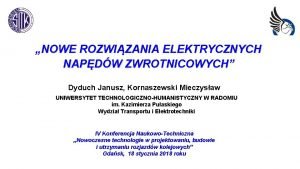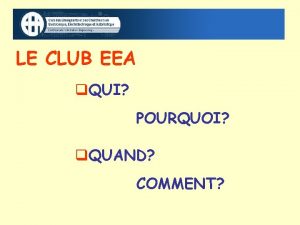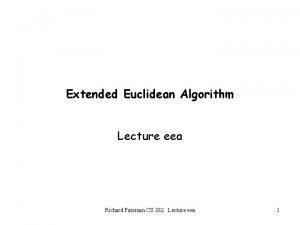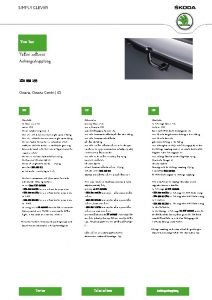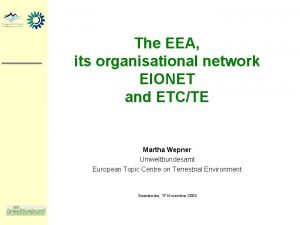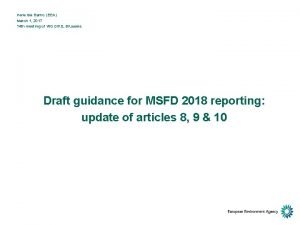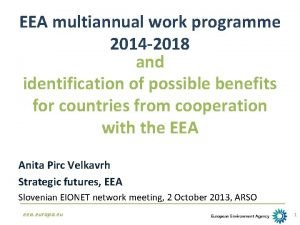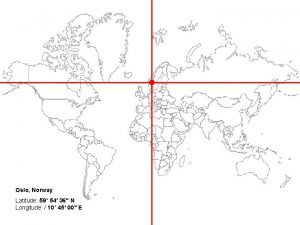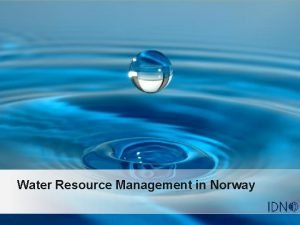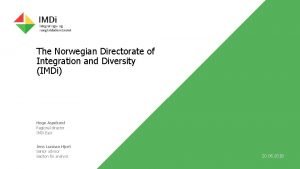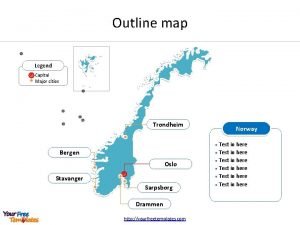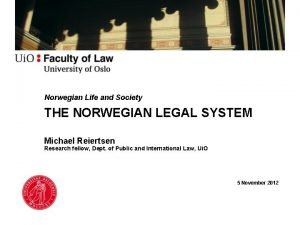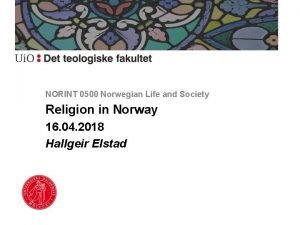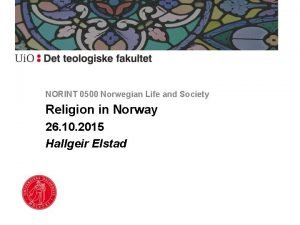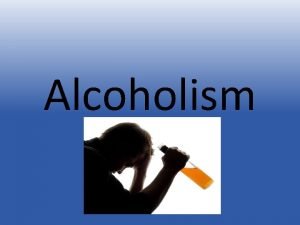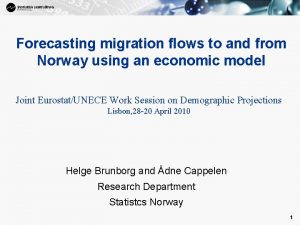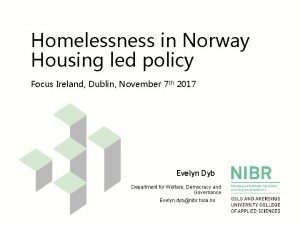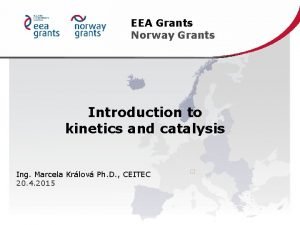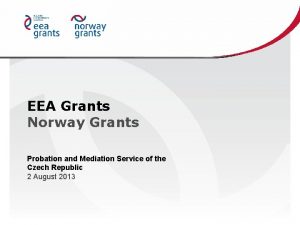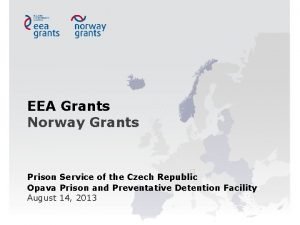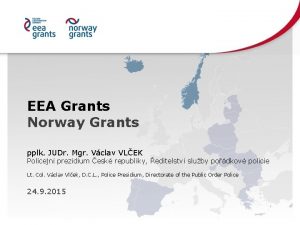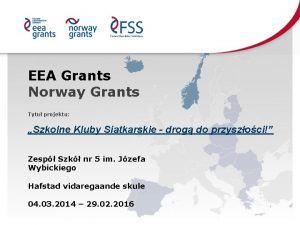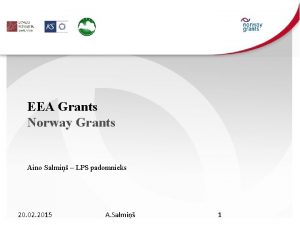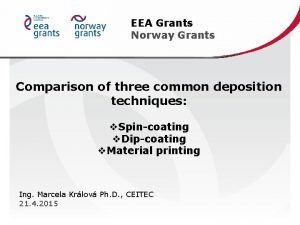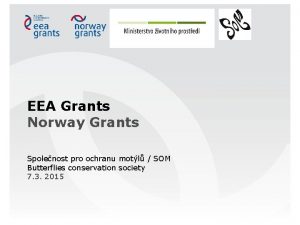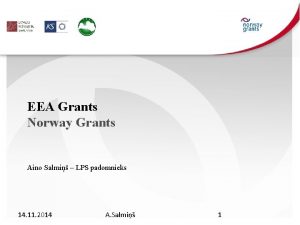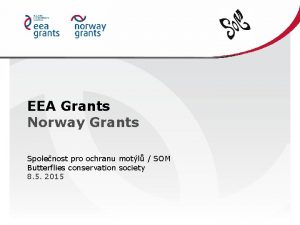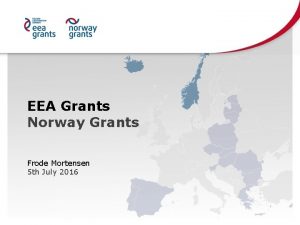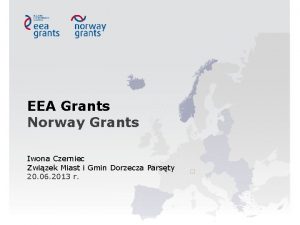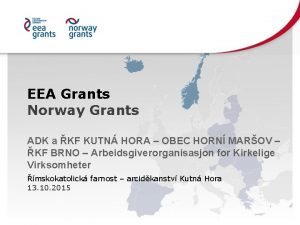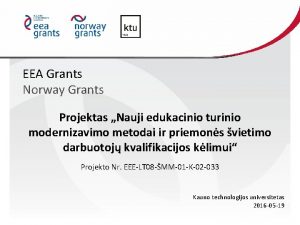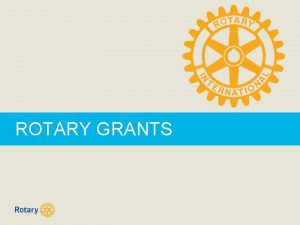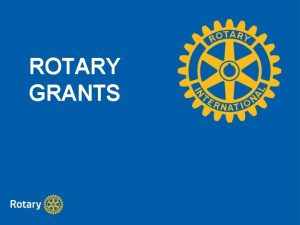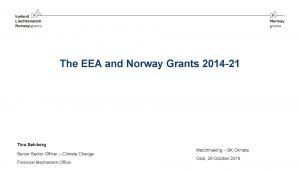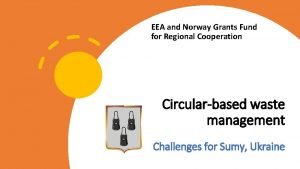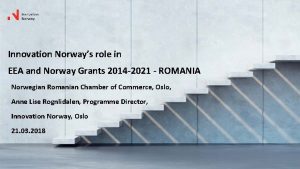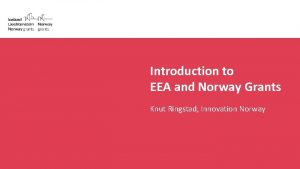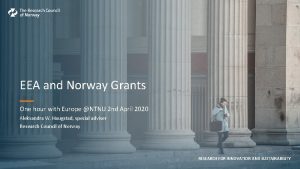EEA and Norway Grants Reporting on results and






























- Slides: 30

EEA and Norway Grants Reporting on results and evaluating health programmes Alex Stimpson Head of Results and Evaluation Programme Operators Meeting Prague, 2 December 2015

Structure Part 1 • Results reporting in the APR • Measuring and reporting on bilateral Part 2 • Evaluation

Where are we now? Health sector results 395, 737 people benefiting from improved health services 7, 050 trained professionals Source: preliminary data provided by POs, November 2015.

The reporting cycle is based on the Annual Programme Report November Donors reports to EFTA October NMFA Annual Report to Parliament February 15 Annual Prog. Report YEAR March 31 NFP Strategic Report 31 March (except CY, MT & SI) Sector Report to Donors FMC Status report to EFTA June Donors’ Annual Report

What are we looking for from the APRS? Structure of the Annual Programme Report And key results sections 1. 2. 3. 4. Executive summary Programme area specific developments Reporting on Outputs Reporting on Programme Outcomes 5. Project selection 6. Progress of bilateral relations 7. 8. 9. 10. 11. 12. Monitoring Need for adjustments Risk management Information and publicity Cross cutting issues Reporting on sustainability WHAT ARE WE LOOKING FOR? • REPORTS THAT DEMONSTRATE RESULTS AND PROGRESS TOWARDS OBJECTIVES • SHORT, ANLAYTICAL • SEE ANNOTATED APR TEMPLATE

2. Programme area specific developments Important developments in the Programme area (including policy, financial or administrative changes). • Refer to justification in programme proposal and provide updates, including potential synergies with EU programmes, that may have an effect on the planned programme results. • Include statistics and analyse trends in the sector and/or the programme area where possible. • If conditions have changed since the programme proposal, do the changes present risks? How might these might be handled?

Context data Example: Suicide rates are important context data for programmes with a strong mental health component. Where does your country stand what are the trends? Suicide rates by country % 40 35 30 25 20 15 10 5 La tv Lit ia hu an ia M al ta Po la n Po d rtu g Ro al m an i Slo a va k Slo ia ve ni a Sp ai n ar y ng Hu ee c e a Gr ni to lic Es ub us pr Re p Cz ec h Cy tia oa ria Cr lga Bu EU -2 8 0 2011 2012

3. Reporting on Programme outcomes Analyse how the projects’ and Programme’s outputs contribute to the expected outcome(s) defined in the Programme proposal. • Use the programme indicators. Refer to baseline studies/provide a situation analysis. • Use a project example for each outcome to demonstrate results. Use another project example to demonstrate bilateral results. • Brief summary of main risks and mitigating actions. • Relevant horizontal concerns • What worked, what didn’t work, and what could be done better?

A Basic Results Chain With Key Prompt Questions Program (Results) Chain of Events (Theory of Action) 7. End results Indirect Influence 6. Practice/behaviour change We want to be around here! Knowledge, attitude, skill and / or aspirations changes 5. Direct Influence 4. We are usually around here with our indicators Reactions Key Questions 7. What is our impact on ‘ends’? 6. Do we influence change? 5. What do people learn? Do we address their needs? 4. WHY? WHAT? How do people learn about us? WHO? 3. Control 2. 1. Engagement / involvement Activities and outputs Inputs 3. Who do we reach? Who participates? 2. What do we offer? How do we deliver? 1. How much does our program cost? (€€s, HR etc) HOW?

Analysing progress and results Key sources of information for your Annual Programme Report These Reports, together with monitoring and evaluation findings, show progress towards results Report 44 Report. Aggregated 15 Individual programme results summaries Report 41 Project information Report 35 Bilateral engagement report Annual Programme Reports: create the ‘story’ of progress towards results and follow it through each level of analysis

Results example: Mental health Annual Programme Reports Describe progress, challenges and opportunities in improving mental health services, contribution of bilateral partners and resulting achievements Grants level objective Improved outcome public Programme health and reduced Improved mental health inequalities services Project(s) e. g. centres, access, rehabilitation systems, screening, services Bilateral engagement DPP/dpp

Context: financials Disbursement and Incurred rates 64% 59% 57% 23% 58% 22% 14% Total all priority sectors Public Health Initiatives Disbursement Rate Conservation and Environmental Protection revitalisation of cultural and Management and national heritage Incurred Rate

Aggregate indicators show significant results • 395, 737 people benefiting from improved health services • 7, 050 trained professionals Source: preliminary data provided by POs, November 2015.

Improved mental health is one of the main priorities Committed grant by outcome (PA 13 and PA 27, %) 27% Improved access to and quality of health services including. . . 18% Life-style related diseases prevented or reduced 17% Improved mental health services 13% Improved access to and quality of health services including. . . 7% Improved prevention and treatment of communicable diseases. . . 7% Reduced inequalities between user groups 5% Developed resources for all levels of health care Improved governance in health care National health registries and health information systems, data. . . 98 projects of a total of 280. 3% 3% 29 projects with a dpp

Programme outcome/outputs… in improved mental health services show: • Concentration in the mental health area • Selected results: – 82% satisfaction of users of integrated mental health services – 9, 237 youth who have benefited from improved mental health services – 3, 000 children and youth get counselling in mental and reproductive health Add project examples that contribute to this story.

‘Ära tee!’ (Don’t do it!) app with self-help functionalities, based on Norwegian app ‘Stop self-harm’ Source: http: //eeagrants. org/News/2015/Web-based-mental -health-services-for-young-people

Progress of bilateral relations Progress towards strengthening bilateral relations: most important achievements and highlights. • Use of bilateral fund to foster/strengthen bilateral relations, including # of partnerships established, events organised, etc. Tips • Follow the 4 bilateral outcome areas. • Assess progress in relation to bilateral ambitions. • Use the bilateral indicators in Do. RIS. • Using specific examples to assess achievements from any events. • Bilateral results are not always captured by indicators, e. g. networks established, contacts established etc. • What worked, what didn’t work, and what could be done better? • • Complementary action: brief summary of results coming from cooperation and exchange of experience with others, if used. Bilateral thinking (Outcomes) • Extent of cooperation • Shared results • Improved knowledge and mutual understanding • Wider effects


Bilateral fund and intensity of project cooperation • Bilateral fund: 9. 5% incurred. • Intensity of cooperation

Norwegian health experts visit projects and find out about Poland's health system Oncology of Wielkopolska - improving and adapting the diagnosis and treatment of cancer Source: http: //eeagrants. org/News/2015/Norwegian-health-authorities-study-visit-to-Poland

Improving health services for young people in Lithuania Following the bilateral fund study visit, Plungė and Bjerkreim have continued their cooperation. The two municipalities have now successfully submitted a project application under the Lithuanian ‘Public Health Initiatives’ programme for improving both the accessibility and quality of youth-friendly health care services in Plungė. Source: http: //eeagrants. org/News/2015/Improving-health-services-foryoung-people-in-Lithuania Teaming up for better health “We are both learning about different approaches in collecting health information, as well as making useful international contacts, ” Source: http: //eeagrants. org/News/2015/Teaming-up-for-better-health

Want to know more? Uploading the APR and good quality indicators http: //eeagrants. org/Results-data/Toolbox-forprogrammes/Do. RIS-manuals-and-training-material

In summary… 1. BE CONCISE 2. ANALYSE AND REPORT ON RESULTS RATHER THAN PROVIDE A DETAILED RECORD 3. ASK THE RIGHT QUESTIONS ACHIEVEMENTS? FOR WHOM? EVIDENCE? (USE DATA AND SPECIFIC EXAMPLES) 4. INCLUDE RISKS AND MITIGATING ACTIONS 5. IT’S ABOUT RESULTS: COHESION, BILATERAL, HORIZONTAL CONCERNS

Structure Part 1 • Results reporting in the APR • Measuring and reporting on bilateral Part 2 • Evaluation

Capturing results 1. Gold standard = programme evaluation Find out what was achieved, who benefitted, how this linked to the programme’s activities 2. Monitoring e. g. find results and effects after projects have finished eg: follow-up survey after 6 months 3. Qualitative results = to capture programme effects that are not included in the programme indicators eg APR, FPR

Ongoing donor evaluations / reviews 1. Bilateral mid-term evaluation (by March-April ’ 16) – – – EE, LV, PL, RO, SK Mainly: Research, Scholarship, Cultural exchange, (Institutional) Capacity building Survey to all POs in the 5 countries 2. Mid-term review of the Grants (by April-May ’ 16) – – – CY, CZ, EE, LT, PL, PT, RO Mainly: Environment, Green Industry Innovation, Justice & Home Affairs, Asylum and Migration, Human and Social development, Health Survey to all … forthcoming 3. Communications review (by May ’ 16) – – – BG, LT, PL, PT, SK Mainly: environment, climate change, green industry, civil society, research and scholarships, justice and home affairs Survey to NFPs now, POs/PPs for case studies in Jan-Feb

More on the mid-term review • Conducted by The Centre for Strategy and Evaluation Services (CSES) • Purpose: assess efficiency and effectiveness of Grants, in particular programme model/implementation and progress towards overall programme objectives. • Methods: desk review, on-line survey and in-depth case studies. • Today: Stephan Kreutzer, Consultant, CSES, here to meet you and learn more about the programmes.

Evaluation (Regulations) The regulations outline responsibilities in terms of evaluation… Article 9. 1 Responsibilities of Beneficiary States • • 1. The Beneficiary State shall carry out evaluations of programmes to assess actual and/or expected effects at the outcome level. It shall present its evaluation plan in the Strategic Report. 2. Evaluation shall be carried out by experts or entities independent of the National Focal Point, the Certifying Authority and the Programme Operator in accordance with the Evaluation Guidelines.

Your evaluation plans? What are your plans for evaluation? In which areas would POs like further support?

Thank you! www. eeagrants. org www. facebook. com/eeanorwaygrants Further questions? Alex Stimpson: ast@efta. int
 Dyduch janusz
Dyduch janusz Eea montpellier
Eea montpellier Eea algorithm
Eea algorithm Edmonton executive association
Edmonton executive association Tan track bar
Tan track bar Eea
Eea Rscs medicina
Rscs medicina Eea
Eea Ninfa innamorata di ulisse
Ninfa innamorata di ulisse Beat reporting examples
Beat reporting examples Latitude of oslo norway
Latitude of oslo norway Sweden and norway use equal quantities of resources
Sweden and norway use equal quantities of resources Living and working in norway
Living and working in norway Halden prison norway
Halden prison norway Norway water resources
Norway water resources Vikings mc norway
Vikings mc norway Imdi norway
Imdi norway Norway russ bus
Norway russ bus Map of norway with major cities
Map of norway with major cities Legal system in norway
Legal system in norway Norway religion
Norway religion Religion in norway
Religion in norway Ncis norway
Ncis norway Norway currency
Norway currency Popultion of norway
Popultion of norway Norway ppp
Norway ppp Western norway university of applied sciences
Western norway university of applied sciences Bixter training
Bixter training Dt kontakt kjell
Dt kontakt kjell Pluralisation
Pluralisation Homelessness in norway
Homelessness in norway
